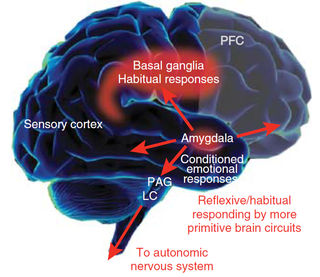Sexual Abuse
Freezing During Sexual Assault and Harassment
Three brain-based responses, keys to understanding experiences and behaviors.
Posted April 3, 2018 Reviewed by Ekua Hagan

People often say “I froze” when trying to describe or explain why they didn’t fight or flee during a sexual assault, school shooting, military ambush, or very stressful experience of sexual harassment.
At first glance “freezing” seems like a simple enough idea. It’s a common word with a meaning that we seem to grasp right away, because it conveys what wasn’t done.
Yet what’s meant isn’t always clear, and scientists have discovered not only complexity but active brain processes underlying freeze responses. (As I’ll discuss in another post, scientists distinguish freezing from other states of immobility under attack, including “tonic immobility,” in which one can’t move or speak despite trying to do so.)
We needn’t make things too complex or simple, but we can understand different forms of freezing and the basics of their neurobiology. Then, by applying that knowledge to sexual assault and harassment, we can better understand the experiences of those who’ve frozen.
In this way, greater clarity can help promote healing and justice: supporting survivors, conducting fair and effective investigations, and increasing the odds of holding perpetrators accountable.
Defense Circuitry in Control
As I’ve explained before, the brain’s “defense circuitry” is a network of regions that constantly scans incoming sensory information for signs of danger and, once an attack is detected or stress otherwise escalates, can rapidly dominate brain functioning.
That circuitry includes the amygdala and several other structures (e.g., specific brainstem areas). That’s why it’s called a circuitry. And it can trigger many responses in the brain and body—much more than could ever be conveyed by the phrase “fight or flight” (or the newly popular “fight, flight, freeze”).
Some of those brain responses are parts of any reaction to danger and being attacked, including all freeze responses. Others are unique to particular types of freezing.
Three Types of Freezing
Scientists broadly define freezing as a response to threat characterized not only by immobility but also inhibition of behavior. In the laboratory, researchers evoke freezing in different ways, some involving the ability to escape and others inescapable. (To dig into the leading research, use the references below.)
By reading the scientific literature closely, and listening carefully to people describing responses they’ve had to sexual assault, severe harassment, and other attacks, it’s possible to differentiate three types of freezing: detection, shocked, and no-good-choices.
As we’ll see, someone who says “I froze” may have experienced one, two, or all three forms. And for neurobiological reasons, if more than one happens, they typically unfold in a set order.
Detection Freezing
In sexual assaults and severe harassment, there’s often a critical moment when the attack is detected and brain and body instantly and automatically enter a completely different state.
Up to that point, the person may have experienced what was happening (even if it was unpleasant, unwanted, and somewhat stressful) as basically normal and consistent with their expectations of how things go in such situations: how people tend to kiss and touch each other in (awkward) romantic situations, how pushy dates can act, and how boorish bosses can be inappropriate.
But then something happens that flips the script or massively escalates the stress, and the brain’s defense circuitry not only detects an unexpected attack, but automatically and involuntarily triggers strong brain and body responses.
This is detection freezing, and to describe it people often say, “I froze for a second.”
I’ve heard accounts of this freezing response many times, like anyone else who talks with people who’ve been sexually assaulted or severely harassed. I’ve encountered it as an expert for legal cases, in police reports and in recordings and transcripts of investigative interviews. Military and law enforcement personnel report this freeze response too, especially to ambushes and other unexpected attacks.
People can have this detection freeze response at different times—some when they first sense something’s wrong, before clear aggression, and others not until the fourth or fifth time their resistance is ignored or overpowered. It can happen when an arm is grabbed, a shirt forcibly unbuttoned, or a rapist flashes a look that says, “You can’t stop me.” Or when someone getting a massage is inappropriately touched the first or second (definitely-no-accident) time.
The potential triggers are limitless, but the detection freeze response is basically the same: instantly and involuntarily, sometimes with a jolt, everything stops and everything changes.
This response can be fleeting, and may not be recalled later—at least not initially, especially if more disturbing experiences happened right before and afterward, or the person is generally avoiding bad memories. Often investigators don’t ask the right questions, or even know it’s a common response and a key moment in many sexual assaults. (It’s a key moment because—from then on—brain, body, attention, thinking, behavior, and memory processes are all dramatically altered in particular ways.)
The detection freeze response doesn’t happen in every sexual assault or incident of severe harassment, especially if escalation and recognition unfold gradually. But when it does, a variety of other brain-based processes tend to follow.
Stopping Behaviors and Thoughts
Obviously, the detection freeze response involves stopping all movement (aside from breathing and visual scanning). That’s why it’s called freezing.
Immobility helps prey avoid the attention of predators. Just as importantly, stopping whatever behaviors were happening just before attack was detected also makes room—literally, in terms of brain network functioning—for new and unplanned behavior options that could prevent injury or death.
Over millions of years, evolution sculpted a specific defense circuitry pathway that carries out that stop-movement or “behavioral inhibition” component of freezing.
Simultaneously, the defense circuitry also instantly stops any thought processes. Research suggests this happens via rapid chemical and electrical changes in regions underlying verbal and visual thinking.
Those sudden cessations of behavior and thought can be understood as a “network reset" (which is initiated by a brainstem area, the locus coeruleus). That reset prepares the brain to receive new and potentially life-saving information—and generate options for responding to it.
Shocked Freezing
The sudden stopping of all movement and thinking may last a fraction of a second, a couple of seconds, or even longer. When it lasts a couple of seconds or less, that’s the detection freezing response.
But when it lasts longer than a couple of seconds, additional brain processes are involved, and it’s a big deal. People tend to remember it.

That’s why many people who’ve been sexually assaulted or severely harassed say that, at some point, “I was in shock” or “My mind went blank,” and of course, “I froze.” Again, some military personnel and police officers say the same things about having frozen in this way (although understandably they seldom admit such things).
I’ve named this remarkable, disturbing, and memorable state the shocked freeze response.
It usually comes right after the detection freeze response, as a continuation of that “network reset”—and a massive amplification of it. For several seconds a person may feel shocked, dumbfounded, their mind utterly blank, at a loss for words and actions. Trying to describe it later, people say things like, “It made no sense,” “It just didn’t compute,” “I couldn’t even think,” or “I had no idea what to do.”
Basically, in this form or phase of freezing, no options for responding even arise in the brain or awareness. It’s not that people experience themselves as having options but can’t decide among them (we’ll get to that). Instead, their brains, at least for a time, are literally not generating any behavior options to choose from, let alone execute.
Research suggests that the strength and length of this shocked freeze state depend on how much norepinephrine the defense circuitry (i.e., its locus coeruleus) has just released into brain regions that generate thoughts and behaviors.
Whatever the exact brain causes, it’s a helpless and horrifying state of being, especially when unwanted and disturbing things are being done to one’s body.
It’s a state that people commonly describe later as having been “frozen.” And like the other two freeze responses, it’s a state that can be listened for, explored with non-leading questions, and put together with other information and evidence—whether to conduct a more effective investigation or simply to validate the experience of someone who feels safe enough to share it with us.
Co-Activating the Autonomic Nervous System
I hope you’re appreciating this fine-grained analysis of what often happens in the first few seconds after freezing has been triggered by a sexual assault or another attack. It gets more interesting and illuminating.
As movement and thought cease and brain networks are reset, the defense circuitry simultaneously activates the autonomic nervous system by slamming on its sympathetic “accelerator” and its parasympathetic “brake.” Scientists call this a “co-activated mode of autonomic control.” (The parasympathetic brake is almost always on to some extent, not just during rest and relaxation – otherwise we’d have resting heart rates of around 110 beats per minute.)
The parasympathetic (vagus) nerve has an insulating sheath (of myelin) that speeds its input to the heart. So when detection freezing kicks in, parasympathetic input is the first to reach the heart, and when it does it slows it down. Once the sympathetic signal finally arrives, over a second later, the heart still doesn’t speed up much, if at all, as long as that parasympathetic brake stays engaged.
In all forms of freezing the parasympathetic branch plays a dominant role. The heart massively accelerates only if the defense circuitry (i.e., the amygdala’s central nucleus) releases that super-fast parasympathetic brake, letting loose full sympathetic activation and surges of oxygenated blood to the muscles.
If you’re heading for a deer in your headlights and the deer’s brain doesn’t snap out of it and let off that parasympathetic brake in time, there’s going to be a crash. And if you’re in shocked freezing during a sexual assault, your brain is not cueing up defensive behaviors, let alone unleashing them while yanking off the autonomic brake.
If you’re in shocked freezing, that assault is going to continue, and later you’re likely to say, “I froze.”
(What about that “adrenaline surge” people talk about? It takes much longer, 2-3 minutes from attack detection or stress onset, for the adrenal glands to release adrenaline into circulation and reach the heart with another wave of sympathetic activation on top of the sympathetic nerve’s direct input. Thus any adrenaline surge has nothing to do with detection freezing, which kicks in instantly, or shocked freezing, which happens within a second or two.)
Impaired Prefrontal Cortex
So the defense circuitry stops all behavior and thought, and slams on the autonomic accelerator and dominant brake. In addition to all of that, it’s also simultaneously unleashing a surge of stress chemicals that can rapidly impair the brain’s rational prefrontal cortex.

To engage in rational thinking our brains must draw on memories and plans, weigh options, and make informed decisions. But that takes time—precious time that could mean life or death in dangerous situations. Evolution has selected brains that can quickly shift control away from the rational-but-slow prefrontal cortex and to fast-acting circuitries that run well-programmed habits and hard-wired reflexes.
Within just a few seconds of attack detection (or stress becoming extreme) the prefrontal cortex can be massively impaired, even effectively taken offline. That’s why the military and police repeatedly train and drill. When they come under attack and their “rational brains” go out the window, habits and reflexes are all that’s left. So their training must burn in effective habits they can access later (although even the best training is no guarantee).
That’s also why, when thoughts do begin to arise again—after detection or shocked freezing have passed—they’re usually very simple thoughts, not complex rational ones.
Not only that, they’re usually very simple thoughts about extreme behaviors that the defense circuitry has just cued up but not yet released into action (just as it hasn’t yet released the parasympathetic brake).
No-Good-Choices Freezing
Many sexual assault survivors recall how, just seconds after registering the perpetrator’s behavior as an attack or upon emerging from a brief state of shock, their thinking was severely limited.
They remember having few thoughts of any kind. They recall, “All I could think was…,” and complete that sentence with a thought or two that—later, from the perspective of a relatively functional prefrontal cortex—seem remarkably simple, even useless or ridiculous.

Some remember being fixated on a single thought. All they could think was, “This can’t be happening, this can’t be happening…” or “It’s almost over, it’s almost over…” or “God please help me...” They had no other thoughts in their minds. Indeed, they had no ability to rationally generate and then choose from other thoughts (about how to respond effectively).
Others find themselves thinking only of two completely opposite responses—both extreme and horrifying: Scream and bring people running to a humiliating scene in my dorm room vs. lie still and quiet. Jump off the massage table and run naked out the door vs. wait for the violations to end. Fight back and risk even worse violence vs. offer no resistance at all.
In short, an impaired prefrontal cortex leaves many people—whether within seconds of the initial detection freeze response, or upon emerging from the shocked freeze response, or otherwise being extremely stressed or terrified—with thinking that’s been reduced to extreme lose-lose options, to “choices” that are no real choices at all.
This is the third form and often the final phase of freezing during sexual assault, severe sexual harassment, and other experiences of violence and trauma. For the reasons explained above, I call it no-good-choices freezing.
As explained in a 2015 article in the Harvard Review of Psychiatry, all freezing is “fight-or-flight put on hold.” The no-good-choices freeze response, with prefrontal cortex impairment and fight-or-flight options cued up but on hold, corresponds to neuroscientist Karin Roelofs’ phrase, “freeze for action.”
What’s held back from release into action? Habit behaviors and survival reflexes that have been automatically cued up by the same defense circuitry that’s also impaired the prefrontal cortex (thereby ensuring that only habits and reflexes are available).
More rational and potentially effective thoughts and behaviors—assuming that any are possible, which is unlikely if the perpetrator is bigger, stronger, willing to escalate the violence—don’t even arise as options in the brain or mind.
Unlike well-trained soldiers, who learn effective habits from extensive combat training, most people being sexually assaulted have no effective habits for responding, because they’ve had no good self-defense or "resistance" training specifically for resisting sexual assault, especially by someone they know. With brains that have no effective habit behaviors to automatically call up and choose from, it’s no wonder they do nothing.
Later, others may ask or think, “Why didn’t you _______?” The answer: Because it never even occurred to them. Again, in response to that “why didn’t you” question, sexual assault survivors commonly say, “I froze. All I could think was…,” and complete that sentence with a simple thought or two about potential behaviors that were not even good options.
(Sometimes in no-good-choices freezing, the parasympathetic braking influence on the heart is outgunned by the sympathetic nerve and a late-arriving surge of adrenaline. People say things like, “my heart was pounding out of my chest!” or “I was in a total panic!” But even then, even if the parasympathetic brake came off, in no-good-choices freezing those cued-up extreme behavior options were still inhibited from release. The body was still “frozen.”)
For these biological reasons, we should never expect people to behave rationally and strategically in such states. We shouldn’t be surprised if they froze because they were stuck on simple thoughts about extreme behaviors that were either wildly over-reactive or totally passive.
Freezing Responses: Keys to Understanding Many Incidents of Sexual Assault and Harassment
Freezing happens in many sexual assaults and incidents of severe harassment.
In all three freeze responses, the brain’s defense circuitry orchestrates massive shifts in brain functioning that have huge effects on experience and behavior. Later, attempting to understand and explain what happened, survivors say things like, “I froze,” “I was in shock,” and “All I could think was…”
In detection freezing, all movement and thinking suddenly stop. In shocked freezing, there’s a blank mind and no behaviors to choose from. In no-good-choices freezing, the brain has cued up only extreme behavior options and there’s little or no prefrontal cortex capacity for rationally choosing among them or coming up with potentially more effective ones.
Sure, some people immediately fight or flee when sexually assaulted or otherwise attacked. But many don’t.
Many victims are suspended for critical seconds in frozen shock, with no thoughts at all—but plenty of terrible sensations bombarding them. Others are stuck with simple thoughts and useless “choices” of extreme behaviors—as the parasympathetic brake stays on, no decision is made, and no action is taken. In many cases, only after one or more of these freeze responses does fight or flight happen, if either happens at all.
Like the brain of every survivor, every incident of sexual assault or severe harassment is unique, and people’s responses can unfold in unique and complex ways. In the aftermath, it can be hard to figure out what happened, especially when memories are incomplete due to the effects of stress, trauma, alcohol or other drugs.
Confronted with that complexity, understanding the three different freeze responses can be very helpful—whether we’re supporting someone who’s been sexually assaulted or harassed, trying to make sense of our own experiences, or investigating or prosecuting such violations of others.
While it may take some time and effort to absorb and apply this knowledge, including through study, training, and practice, it’s definitely worth it. This knowledge can help all of us to listen with less confusion and more understanding, with less judgment and more empathy. And those are keys to supporting survivors, conducting effective and fair investigations, and holding perpetrators accountable.
References
Amir A., Lee S. C., Headley D. B., Herzallah M. M., & Pare, D. (2015). Amygdala signaling during foraging in a hazardous environment. The Journal of Neuroscience, 35, 12994-13005.
Arnsten, A. F. T. (2015). Stress weakens prefrontal networks: Molecular insults to higher cognition. Nature Neuroscience, 18, 1376-1385.
Aston-Jones, G., Rajkowski, J., & Cohen, J. (1999). Role of locus coeruleus in attention and behavioral flexibility. Biological Psychiatry, 46, 1309-1320.
Berntsen, G. G., Cacioppo, J. T., Quigley, K. S. (1991). Autonomic determinism: The modes of autonomic control, the doctrine of autonomic space, and the laws of autonomic constraint. Psychological Review, 98, 459-487.
Berntsen, G. G., Cacioppo, J. T., Quigley, K. S. (1993). Cardiac psychophysiology and autonomic space in humans: Empirical perspectives and conceptual limitations. Psychological Bulletin, 114, 296-322.
Bouret, S., & Sara, S. J. (2005). Network reset: A simplified overarching theory of locus coeruleus noradrenaline function. Trends in Neurosciences, 28, 574-582.
Choi, J. S., & Kim, J. J. (2010). Amygdala regulates risk of predation in rats foraging in a dynamic fear environment. Proceedings of the National Academy of Sciences, 107, 21773-21777.
Dayan, P., & Yu, A. J. (2006). Phasic norepinephrine: a neural interrupt signal for unexpected events. Network: Computation in Neural Systems, 17, 335-350.
Devauges, V., & Sara, S. J. (1990). Activation of the noradrenergic system facilitates an attentional shift in the rat. Behavioural Brain Research, 39, 19-28.
Guedj, C., et al. (2017). Boosting norepinephrine transmission triggers flexible reconfiguration of brain networks at rest. Cerebral Cortex, 27, 4691-4700.
Hagenaars, M. A., Oitzl, M., & Roelofs, K. (2014). Updating freeze: Aligning human and animal research. Neuroscience and Biobehavioral Reviews, 47, 165-176.
Hagenaars, M. A., Roelofs, K., & Stins, J. F. (2014). Human freezing in response to affective films. Anxiety, Stress, & Coping, 27, 27-37.
Hermans, E. J, Henckens, M. J., Roelofs, K., Fernández G. (2013). Fear bradycardia and activation of the human periaqueductal grey. Neuroimage, 66, 278-287.
Kozlowska, K., et al. (2015). Fear and the defense cascade: Clinical implications and management. Harvard Review of Psychiatry, 23, 263-287.
Ly, V., Roijendijk, L., Hazebroek, H., Tonnaer, C., & Hagenaars, M. A. (2017). Incidence experience predicts freezing-like responses in firefighters. PLoS One, 12, e0186648.
Mather, M., et al. (2016). Norepinephrine ignites local hotspots of neuronal excitation: How arousal amplifies selectivity in perception and memory. Behavioral and Brain Sciences, 39, e200.
Mobbs, D., et al. (2007). When threat is near: Threat imminence elicits prefrontal-periaqueductal gray shifts in humans. Science, 317, 1079-1083.
Pare, D., & Quirk, D. J. (2017). When scientific paradigms lead to tunnel vision: lessons from the study of fear. npj Science of Learning, 2, 1-8.
Rickenbacher, E., Perry, R. E., Sullivan, R. M., & Moita, M. A. Freezing suppression by oxytocin in central amygdala allows alternate defensive behaviours and mother-pup interactions. eLife, 6, e24080.
Roelofs, K. (2017). Freeze for action: Neurobiological mechanisms in animal and human freezing. Philosophical Transactions of the Royal Society of London B: Biological Sciences, 372, 20160206.
Sara, S. J., & Bouret, S. (2012). Orienting and reorienting: The locus coeruleus mediates cognition through arousal. Neuron, 76, 130-141.
Schwabe, L. (2017). Memory under stress: From single systems to network changes. European Journal of Neuroscience, 45, 478-489.
Toyote, P., et al. (2016). Midbrain circuits for defensive behavior. Nature, 534, 206-212.




